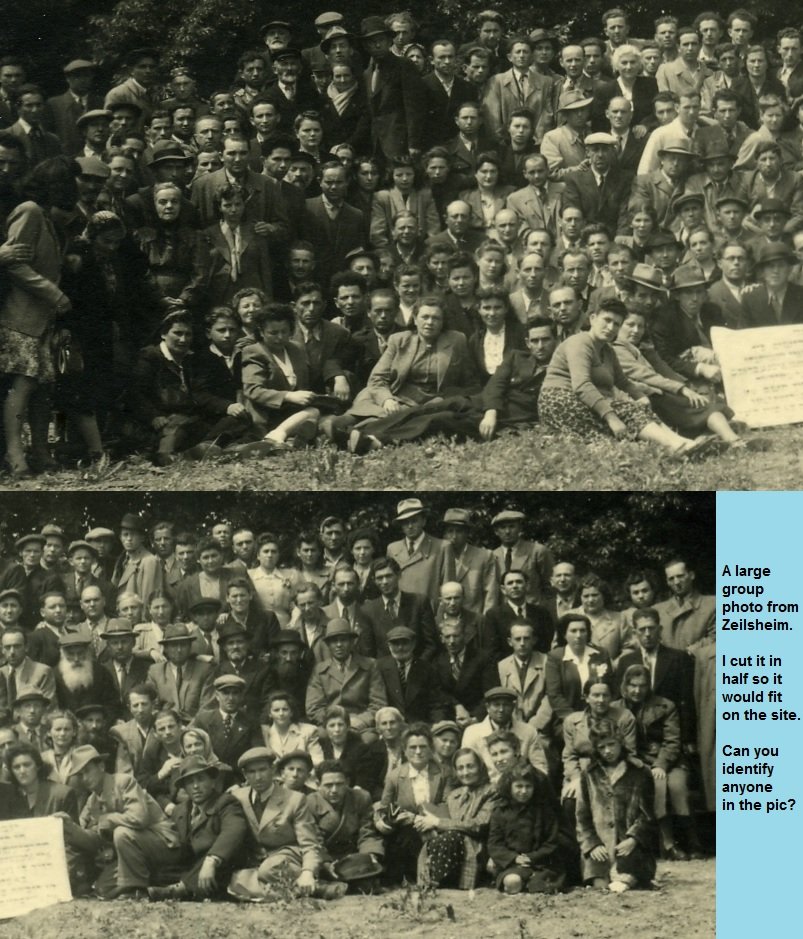Memorial for the Jewish Displaced Persons Camp at Zeilsheim
Zeilsheim (pronounced Saltzheim) was a DP camp 12 miles west of Frankfurt in the American-occupied zone. Zeilsheim's German homes (small townhouses, 2-3 stories) were requisitioned to accommodate inhabitants of the DP camp. The streets and building complexes of Zeilsheim were named after towns and kibbutzim in Palestine. Zeilsheim maintained a Jewish theatrical group, a synagogue, a jazz orchestra, a sports club named "Chasmonai", and a number of schools, including an ORT school. The camp had a library with approximately 500 books, and circulated two Yiddish newspapers: Unterwegs (In Transit) and Undzer Mut (Our Courage). The population in the camp reached 3,570 in Oct. of 1946 and may have reached 5,000 Jews before discontinuation.
The Zeilsheim camp was not typical of other DP camps, because it was not a former Concentration Camp site but a suburb where IG Farben chemical plant workers had lived. So Zeilsheim residents actually had homes rather than barracks, but the conditions were very cramped. Supplies were provided by UNRRA and American Jewish aid organizations. An autonomous society developed which included elementary schools, a high school, religious institutions, political parties, youth organizations, newspapers, and more. A publication called Zentrale Historische Kommission collected documents, photos, and songs from the concentration camps and published them in a journal called Fun letztn khurbn, printed in Munich. A special section interviewed child survivors of the Holocaust. The DP camp was seen by the survivors, understandably, as temporary housing. None of them wanted to stay. Most of the survivors of the Zeilsheim Displaced Persons Camp went to America or Israel between 1945 and 1949.
Zeilsheim was also the site of many protests against British policy on Jewish immigration to Palestine. Gen. Eisenhower's first advisor on Jewish affairs in the European Theatre of Operations, Judah Nadich, made frequent visits to the camp in an effort to see that the basic requirements of DPs were met. David Ben Gurion, then the chairman of the Executive of the Jewish Agency, also visited the camp. His personal inspection of Zeilsheim was a pivotal event in the lives of Jewish DPs.
The camp closed on Nov. 15, 1948, after a dispute between rabbinic authorities and the U.S. army. Rabbi Philip Bernstein, Adviser on Jewish Affairs to U.S. military authorities in Germany and Austria, believed that closing the camp would be cruel to the DPs, most of whom just had survived concentration camps. But the U.S. Army wanted to return the houses to workers from the IG Farben plant in nearby Hechst. After postponing the close of the camp until after the state of Israel was formed, the camp was finally closed, but Holocaust survivors still protested the move. It was also called the Frankfurt DP camp.
LINKS
Zeilsheim DP Camp - More Photos:
- More Photos of the Zeilsheim DP Camp
Zeilsheim DP Camp - Articles:
- In 2010, Students of Darmstadt Explore DP Camp Zeilsheim
- Darmstadt Students Research Jewish DP Camp Zeilsheim
- "Rebuilding Jewish Lives in Postwar Germany" Excerpt on Zeilsheim DP Camp
Zeilsheim DP Camp - Oral History:
- Rose Wagner Testimony
- Footage from the DP camp (recorded by the Lev family)
Zeilsheim DP Camp - Survivors:
- Judah and Tauba Biterman
- Michael Finger Drori
- Sam Genirburg
- Majer and Manja Mulsztajn
- Sima Ya'akobowic (Yakobovich)




